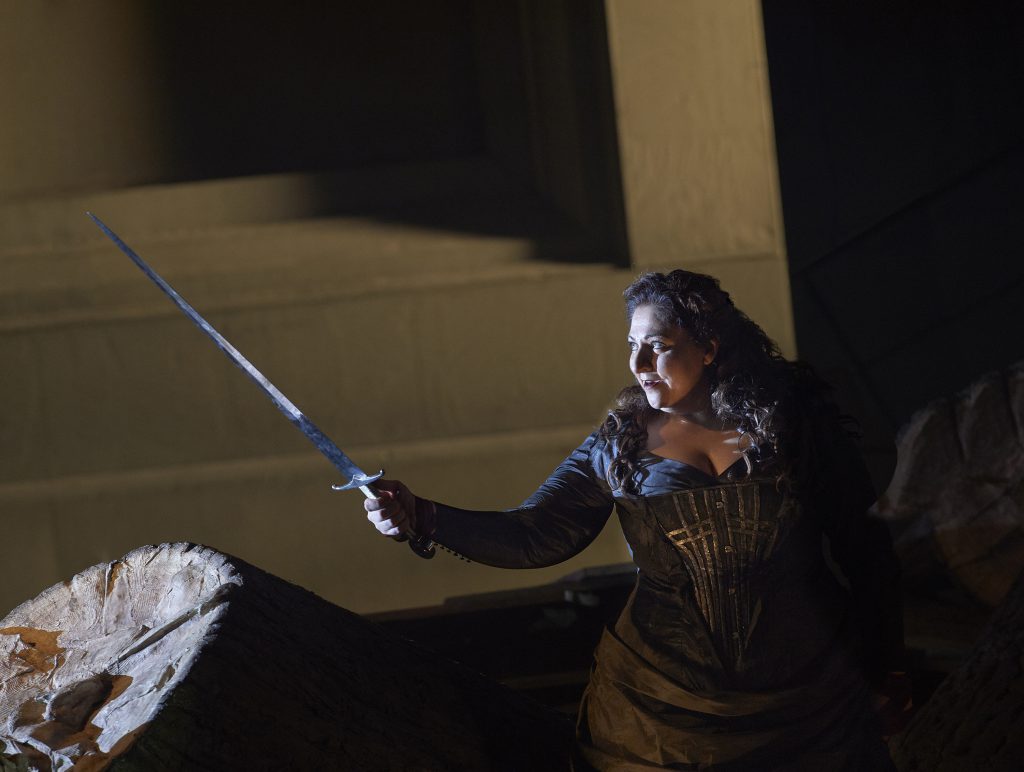Die Walküre (The Valkyrie), the second instalment in Richard Wagner’s vast 4-part Der Ring des Nibelungen (The Ring of the Nibelung), like most of his colossal epic, was essentially an afterthought. Originally conceived as a single opera chronicling the death of the Romantic hero Siegfried, The Ring spontaneously grew in ambition and scale. Begun as a prose outline sometime around 1850 focused exclusively on Siegfried’s demise, Wagner soon came to realize that a prequel would be needed to add context to his protagonist’s tale. Before composition had begun, he had broadened the story arc even further with Das Rheingold (The Rhine Gold), a comparatively brisk introduction to his sprawling meta myth, concluding with the monumental final episode, Götterdämmerung (Twilight of the Gods). The task of single-handedly crafting the complete 16-plus hour libretto and score for The Ring wore on for over twenty years, obsessing and taxing the composer for virtually the entire duration of his later life. With its immense universe of sound, the music seemingly unbounded, Die Walküre, frequently extracted from the cycle as a one-off, epitomizes Wagner’s mastery of symphonic harmony and orchestration arguably unsurpassed in opera to this day.
First presented as a solo production in 2004, restaged in 2006 as part of then General Director Richard Bradshaw‘s inaugural Four Seasons Centre Ring, the Canadian Opera Company reprises a still stunning Die Walküre, dramatically proportioned, gloriously performed. Under the guidance of its original creators, Director Atom Egoyan and Designer Michael Levine, the pair’s raw, post apocalyptic vision continues to shock and awe.
The narrative framework for Die Walküre, like The Ring at large, derives in general terms from Northern European folklore anonymously recast as popular medieval tales. For the most part, Wagner ignored the specifics of these old Germanic – Icelandic sagas in favour of characters and anecdotes further reshaped to suit his own self-invented libretto. The Nordic classics were less valued as revered literature by the composer, more as a source of intricate archetypes, darkly primal, sharply compelling. Once entered into, the world of Die Walküre overwhelms.
A ragged stranger stumbles across a crude hut hidden in a desolate forest. A grim-faced young woman discovers him and invites him to rest awhile. She and the stranger are struck by a vague sense of shared recognition. The woman’s husband, Hunding, enters, returned from the hunt. In answer to his inquiries, the stranger recounts his tale. He is known as Wehwalt, the woeful one, to his Wälsung clan. His home laid waste by his family’s enemies, his mother slain, his twin sister and father disappeared, Wehwalt, menaced by merciless foes, has roamed the savage countryside for years, shunned by all he meets. A recent clash with a fierce tribe has left him wounded and weaponless. Hunding curses Wehwalt’s name. It was his kinsmen whom he slaughtered. He will avenge them with Wehwalt’s blood at dawn. Wehwalt recalls his father Wälse’s promise that he would be provided with an invincible sword in his direst moment of need. Hunding’s wife, drawn to Wehwalt by some strange, mystic bond, secretly drugs her husband’s nightly draught, sending him into a heavy sleep. Little by little, she and the stranger come to realize that they are brother and sister, Siegmund and Sieglinde. Parted by misfortune, each has been cast to their separate fates, Sieglinde to forced marriage to Hunding, Siegmund to bitter exile. Their eternal love and passion for one another shall set them free. Sieglinde directs Siegmund to a great sword embedded in a fallen tree. A mysterious traveller thrust it into the shattered trunk as Sieglinde was about to be wed. All who have sought to claim it have failed. Siegmund draws the gleaming blade from the tree with ease. He and Sieglinde vanish into the night.
Wotan, ruler of the gods, enlists the aid of his warrior daughter, the Valkyrie Brünnhilde, to guarantee Siegmund’s victory in the battle with Hunding to come. Wotan’s wife, Fricka, appears. Appalled and enraged at Siegmund and Sieglinde’s incestuous coupling, Fricka commands him to withdraw his divine protection of the vile Wälsung. It was Wotan masquerading as Wälse who fathered Siegmund and Sieglinde and granted Siegmund his enchanted sword. Wotan reluctantly agrees to his furious wife’s demand. Alone with Brünnhilde, he reveals his sinister past made murkier by a tangle of weighty commitments forced on him by his ominous allies. Siegmund, dauntless hero, was his best hope to win back a magic ring guarded by a fearsome giant. Wotan’s survival as god supreme depends on recovering it. Woeful and dispirited, he redirects Brünnhilde to ensure Siegmund dies at Hunding’s hand. Brünnhilde’s will to obey holds firm until required to confront Siegmund and reveal his fate. Although his sister will be safeguarded, Sieglinde will not be allowed to join Siegmund in death. Valhalla is reserved for gods and fallen champions. Lamenting a future without her, Siegmund threatens to take his sister’s life followed by his own. Her heart softened by his desperation, Brünnhilde relents and recklessly agrees to shield Siegmund from harm. Hunding approaches. Siegmund raises his sword. Suddenly, Wotan re-emerges, splintering the blade with a single blow of his spear. Hunding slays Siegmund. Brünnhilde flees with Sieglinde. Wotan strikes down Hunding, vowing retribution for his daughter’s disobedience.
Atop a lofty mountain, Brünnhilde’s Valkyrie sisters convey slain heroes to Valhalla. Brünnhilde arrives, Sieglinde safely at her side. She shall bear Siegmund’s child, Brünnhilde prophesizes. The greatest of all mortal heroes, he shall be called, Siegfried. Sieglinde rejoices. Wotan stalks into the scene. Fear grips the Valkyries. Casting his beloved daughter into a deep, insensate sleep as punishment, Wotan surrounds her with a ring of magic fire that will burn protectively until the day a worthy warrior braves the flames and awakens her. Overcome with grief, Wotan slips away.
Wagner consciously turned aside from traditional operatic forms in his late period works, preferring to call them “musical dramas”. Die Walküre, premiered in June 1870 at the Nationaltheater München, fits neatly into the rebellious composer’s distinctive frame of reference. His notion of Gesamtkuntswerk (“total artwork”), adopted as a guiding principle, evoked a classic Greek ideal that sought to synthesize singing, drama, performance practice and stagecraft into a single coherent theatrical experience.
From the point of view of libretto, Die Walküre is more than mere narrative although the story is intensely gripping and riddled with excitement. The rolling patterns of Homeric-like verse and rhyme plus taut, urgent rhythms combine almost organically to produce something quite unique. Wagner’s extended song poetry with music voiced in text and vice versa resounds, as does its theme. This is an opera haunted by the horrors of war and vicious tribalism, an emotional roller coaster that hurls us from the heights of love to the depths of vengeance, an anthem of hope and a prayer for humanity. Power corrupts the powerful. The innocent suffer.
Die Walküre’s lush, limitless music tells all. The orchestra, numbering well over a hundred players, unleashes tides of recurring themes and symphonic patterns. Arias are banished, replaced by stirring, impassioned declarations of attitude and intention. The atmosphere is as psychological as it is overtly dramatic. But it is the sheer volume of bold musical colours that perhaps impresses most. The promise of spring is announced by budding woodwinds. Wotan materializes in darkness and storm to disarm Siegmund in a crash of timpani and blare of brass. Die Walküre’s vast tonal panoramas are as stunning as they are magnificently crafted. This is an expansive, sweeping work, appealing on a multitude of levels.
Leading his cast of seasoned Wagnerians, Director Adam Egoyan carefully, confidently picks his way through the tangle of toppled steel and ravelled cables that forms his set, the palace of a god gone mad, a place of demented industry and obsession on the verge of total collapse.
Appearing as Siegmund and Sieglinde, heldentenor Clifton Forbis and dramatic soprano Heidi Melton sing with ferocious strength and riveting commitment, bringing enormous dynamism to their roles. Forbis gives moving expression to his Siegmund’s frantic, futile attempts to claw back a life snatched from him by evil misfortune. Melton sings with superb virtuosity, a confused, terrified refugee fleeing a violent past.
Johan Reuter sings Wotan in a performance of towering grandeur shading to anguish and regret. The great god’s bitter rant, a painful admission of his decidedly ungodly fallibility and wrong-doing, Was keinem in Worten ich künde (“That which I tell in words to no man”) as voiced by this engaging, warm-hued baritone, is utterly wrenching.
Christine Goerke, widely heralded as the Brünnhilde of her generation, surpasses all expectations as Wagner’s soaring, iconic heroine. Goerke is a singer actor of consummate technical skill but also one possessed of a palpable humanity on stage. The father-daughter relationship of Wotan-Valkyrie is given an insightful, deeply compassionate reading by this sensitive super soprano, transcending any hint of artificiality. Love and devotion, pain and hurt, overflow in endless streams of exquisite, heartrending musicality.
Bass Dimitry Ivashchenko sings a menacing Hunding, a primitive, half-tamed man-beast. Mezzo Janina Baechle is a stormy Fricka, seething and thunderous.
Dazzling performances by the eight Valkyrie sisters culminate in a spectacular torch lit procession ablaze with primeval flames.
The Canadian Opera Company Orchestra conducted by resident Music Director Johannes Debus plays with tireless vitality and verve. Leitmotifs are crisp, clear and vividly expressed. Orchestral colours are resplendent. The Ride of the Valkyries has never been more rousing, Magic Fire Music never more glowing.
Die Walküre is a colossal work, towering in its aspirations, mountainous in its artistic demands. Daring and unafraid, the Canadian Opera Company takes us on a thrilling, 4½-hour climb to the top. The views are breathtaking.


